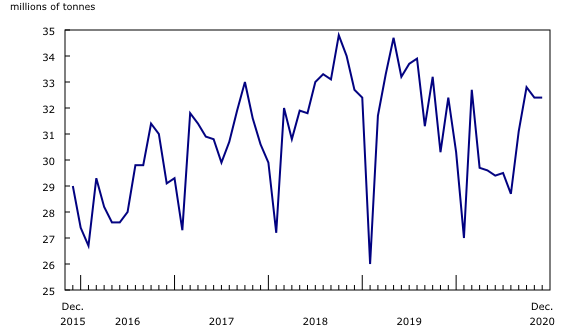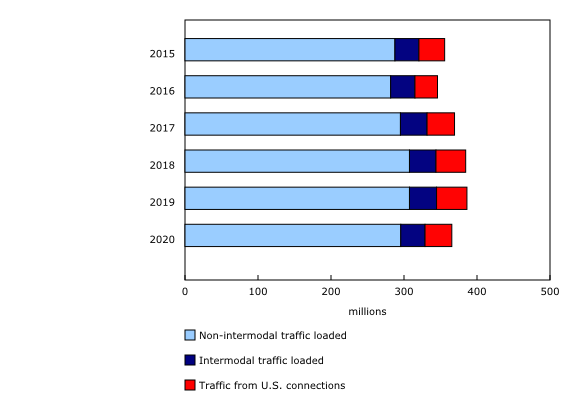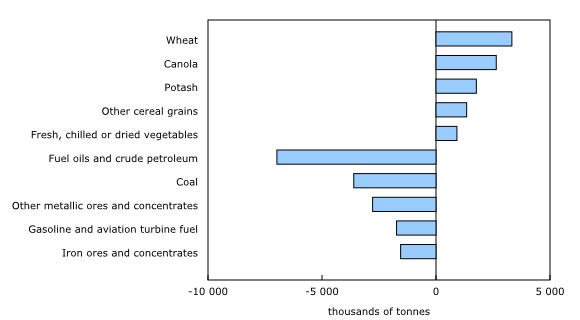Railway carloadings, December 2020
Archived Content
Information identified as archived is provided for reference, research or recordkeeping purposes. It is not subject to the Government of Canada Web Standards and has not been altered or updated since it was archived. Please "contact us" to request a format other than those available.
Released: 2021-02-24
32.4 million metric tonnes
December 2020
0.0% 
(12-month change)
Highlights
In December, Canadian railways carried 32.4 million tonnes of freight, an amount unchanged (0.0%) from December 2019, and the second highest on record for the month of December. Following a strong 6.0% year-over-year growth in November, this signals a recovery to more seasonal levels after seven straight months of year-over-year declines since March.
The year in review, 2020
The volume of freight moved by rail in Canada depends on many factors, ranging from seasonality and weather that can affect train lengths to the economic cycle along with global price fluctuations and one-time shocks. Many factors influenced rail freight transport in 2020, beginning with rail blockades erected in February 2020 to support the Wet'suwet'en First Nation. The impact was somewhat moderated because blockades in Western Canada, where almost two-thirds of railway carloadings are shipped, were in place for about half as long as those in Eastern Canada.
By March, the COVID-19 pandemic had already dampened manufacturing sales and was starting to disrupt supply chains, but its full impact was not yet felt by the railways. Then in April, freight volume shipped by rail fell 10.0% relative to April 2019, the first of five consecutive year-over-year double-digit declines. In the fall, volumes started to move closer to pre-pandemic levels and November's 6.0% year-over-year increase followed by solid results in December, signalled that rail freight had more or less recovered to pre-pandemic levels, albeit with a different commodity composition.
On the whole, the volume of rail freight in 2020 amounted to 365.5 million tonnes, a decrease of 5.4% from 2019. While this marked the first such decline in four years, freight volume remained close to the five-year annual average. While non-intermodal freight loadings in Canada fell 3.9% to 295.6 million tonnes, intermodal freight traffic was down 10.7% to 33.2 million tonnes, the lowest annual level in four years. Finally, freight traffic coming from the United States saw a year-over-year decline for the first time in four years, dipping 11.7% to 36.7 million tonnes.
Key commodity shift in 2020
Overall, the tonnage of rail freight moved in 2020 ended near pre-pandemic levels. Helping to transport essential goods throughout the pandemic, the rail freight industry was not directly affected by COVID-19 restrictions, as was passenger transport for example. That said, COVID-19 brought significant changes during 2020 to the types of commodities moved by rail—the most evident a shift from energy-related commodities to agricultural and food products.
With weaker energy demand coming from travel restrictions and shuttered economies, energy-based commodities experienced large declines relative to 2019. With loadings of 14.3 million tonnes, fuel oil and crude petroleum were down 32.7% in 2020, following large year-over-year growth in 2018 (+45.1%) and 2019 (+13.2%). Similarly, coal loadings fell for the first time in five years in 2020, down 9.7% from 2019 to 33.5 million tonnes while gasoline and aviation turbine fuel loadings dropped 49.4% to 1.8 million tonnes in 2020. Other declines were reported for other metallic ores and concentrates (-44.5%) and for iron ores and concentrates (-2.7%).
However, large year-over-year increases in loadings of agricultural and food-related products offset these declines during 2020. Compared with 2019, wheat loadings increased by 13.7% to 27.5 million tonnes while canola loadings were up 26.4%, reaching 12.6 million tonnes. Similarly, loadings of other cereal grains grew 28.8% year-over-year to 6.0 million tonnes in 2020, while fresh, chilled or dried vegetables were up 18.9% to 5.8 million tonnes. Loadings of potash reached 22.4 million tonnes in 2020, up 8.6% from 2019.
Focus on December 2020
Traffic from domestic freight operations increased in December. Intermodal or container traffic in Canada was up 6.3% to 3.1 million tonnes compared with December 2019, marking the fourth consecutive month of year-over-year increases.
In December, non-intermodal freight loadings also grew 0.7% to 26.3 million tonnes. The main contributors to this year-over-year increase were loadings of agricultural and food products, principally wheat (+21.4%, or +420 000 tonnes), followed by potash (+21.9%, or +371 000 tonnes), iron ores and concentrates (+8.3%, or +365 000 tonnes), oil seeds and nuts and other agricultural products (+82.4%, or +262 000 tonnes) as well as other cereal grains (+21.0%, or +128 000 tonnes).
Moderating this growth were large year-over-year declines in loadings of certain hydrocarbon-based commodities, notably fuel oils and crude petroleum (-40.5%, or -917 000 tonnes), coal (-11.5% or -372 000 tonnes), gasoline and aviation turbine fuel (-42.9%, or-114 000 tonnes). Compared with December 2019, other significant decreases were also reported in other metallic ores and concentrates (-27.6%, or -111 000 tonnes) along with iron and steel (-21.3%, or -93 000 tonnes).
In December, traffic received from the United States remained well below December of 2019 levels, falling 10.7% to 3.0 million tonnes, the ninth consecutive month of decline.
Note to readers
Data from January 2020 to the month preceding the reference period have been revised. The data in this release are not seasonally adjusted.
The Monthly Railway Carloadings Survey collects data on the number of rail cars, tonnage, units and 20-feet equivalent units from railway transporters operating in Canada that provide for-hire freight services.
The Transportation Data and Information Hub, a web portal developed jointly by Statistics Canada and Transport Canada, provides Canadians with online access to comprehensive statistics and measures on the country's transportation sector.
Contact information
For more information, or to enquire about the concepts, methods or data quality of this release, contact us (toll-free 1-800-263-1136; 514-283-8300; STATCAN.infostats-infostats.STATCAN@canada.ca) or Media Relations (613-951-4636; STATCAN.mediahotline-ligneinfomedias.STATCAN@canada.ca).
- Date modified:




